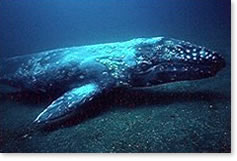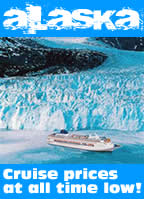Gray whales thrive in the Alaska Arctic, for now, effects of global warming not clear
6/27/06Juneau, Alaska
The number of baby gray whales born along the Pacific Coast has increased over the last five years, leading scientists to believe that for now the pregnant females are doing all right feeding in a warming Arctic environment.
National Oceanic and Atmospheric Administration researchers counting the calves that passed Point Piedras Blancas near San Luis Obispo tabulated 1,018 calves in 2006, up from 945 in 2005. The whales migrate about 5,400 miles a year on their way to summer feeding grounds off the coast of Alaska, roaming February to May past popular whale-watching spots such as Half Moon Bay State Park and Point Reyes National Seashore.
The agency reports an upward trend since the counts of 3-month-old, 20-foot-long whales plummeted below 300 in the years 2000 and 2001. The counts began in 1994.
"It's a reasonable level of reproduction, and the overall trend over the past five years is positive," said Wayne Perryman, a fisheries biologist with NOAA in La Jolla (San Diego County).
"In the short term, they appear to be doing well, based on our monitoring of reproduction. But we really don't know how the long-term warming trend is going to affect this population," Perryman said.
Scientists report a major shift in the ecosystem of the northern Bering Sea, the whale's traditional feeding ground, because of warming air and water in the Arctic. The whale's favored prey, the fatty amphipod, is less abundant, sending the animal searching for food farther north.
But, say scientists, the whales have taken advantage of polar sea ice that melted in the spring, opening up new passageways to food supplies farther north near Barrow, Alaska.
California's calf count, sometimes conducted only dozens of yards away from the whales offshore, serves as a way to measure the health of the population, considering the expense and difficulty of a whole population count. The last complete census was taken in 2001, and the estimates ranged from 17,000 to 27,000.
Just as scientists watch to see how the polar bear, the ringed seal and the walrus respond to environmental changes due to the shrinking pack ice, they also watch the gray whale, which has fed for thousands of years in the northern Bering Sea.
In the summer of 1997, an El Niņo year, scientists recorded the warmest water temperatures on record in parts of the Bering Sea. Since then, the amphipods have dropped in numbers in the northern Bering Sea, including beds in the Chirikov Basin.
In 1999, the number of whales that washed up dead or dying on the Pacific Coast went up 10-fold to about 270, according to NOAA. Some were malnourished; others were not.
But in recent years, NOAA scientists and others have found the gray whale moving to the Chukchi Sea off Barrow, apparently searching for -- and finding -- enough crustaceans in the mud to nourish the pregnant females.
Perryman thinks the pregnant females are now doing well when they reach the Arctic in the spring.
"They are the first animals there" when they arrive, probably starting in May, he said. Even though they have to go farther north to find food, scientists believe the whales can get to it more easily because of the earlier sea ice melt that allows them to move through open ocean waters, he said.
"What we find is a relationship between the timing of the melt of sea ice in the Arctic and the number of calves we see the next season. This past year, the ice has been light, and we've had really good recruitment in calves,"
Perryman said. "Think of the sea ice as a table. The polar bears feed on the sea ice. But the gray whales don't have access to the bottom of the ocean when the table's there. So, you have to pull the table away for them to find food,"
Perryman said. He cautioned that there has been no study determining whether the individual whales are able to put on as much weight as needed given their lengthy route to find food and the changing food supply. The gray whales don't eat krill that float in the water the way blue, humpback and bowhead whales do. They scoop up the mud on the floor of the continental shelf and sift out the sea life.
Jacqueline Grebmeier -- a biological oceanography professor at the University of Tennessee and lead author on an ecosystem shift study published in the journal Science in March -- said the whales were staying up in the north and foraging longer, taking advantage of a greater expanse of open waters, which aren't blocked with ice again until the fall.
But she noted that the changing ecosystem raises questions.
"If they go farther north, they have to spend more energy."
Also, the gray whale may be at the end of its feeding range, she said, because it relies on the shallow continental shelf in the Pacific Ocean -- and not the Arctic Ocean, where the continental shelf is narrow, with less room for foraging.
"For now, it's time and space playing in their favor. But at some time in the future, the space issue will become a limiting factor."

